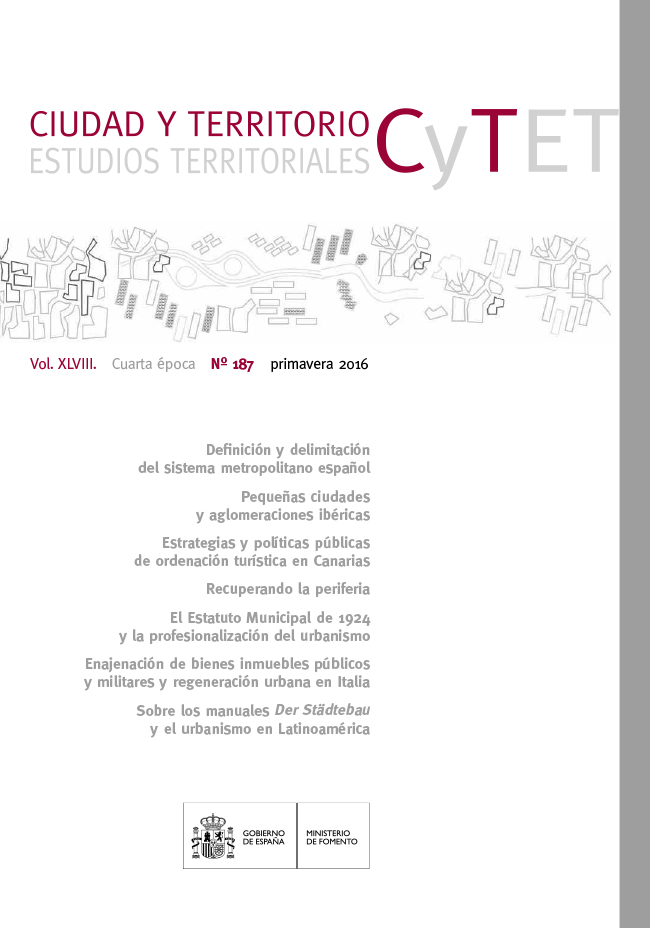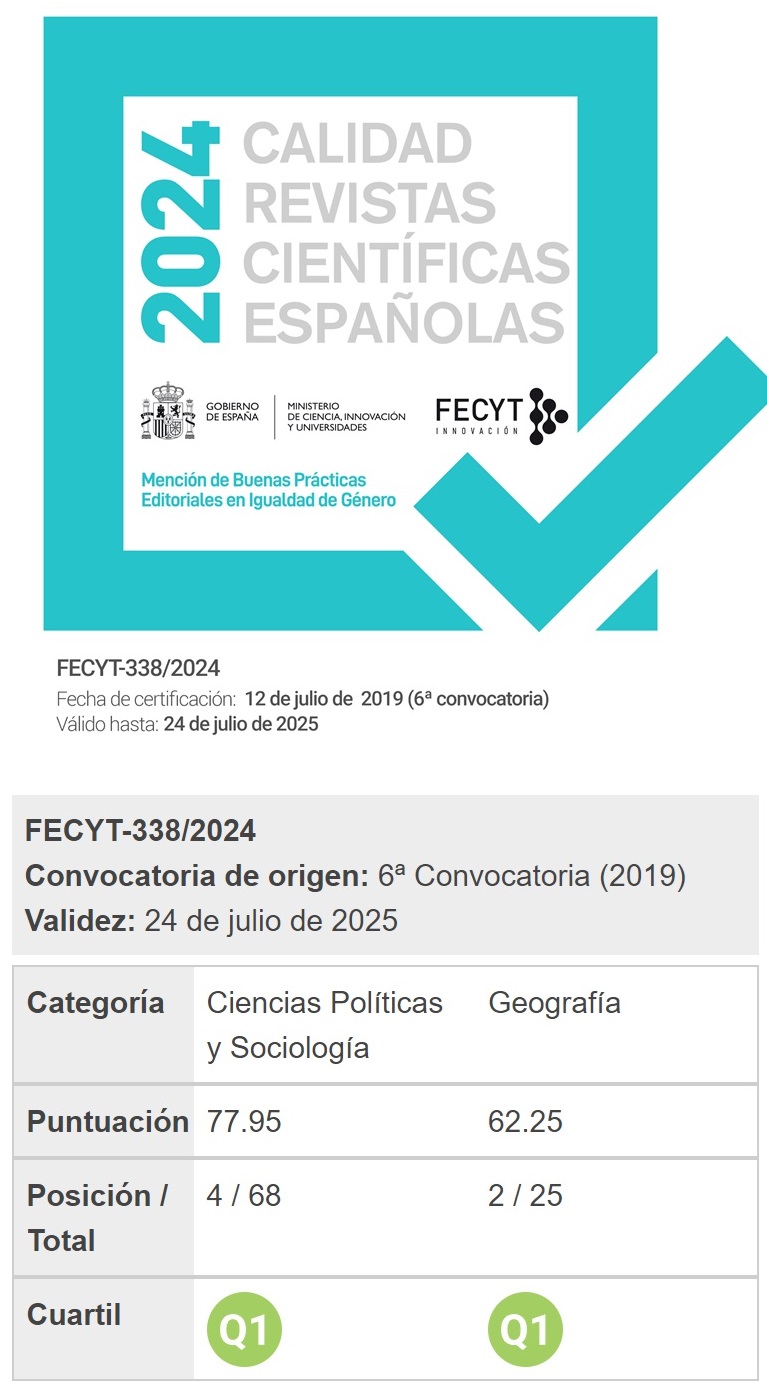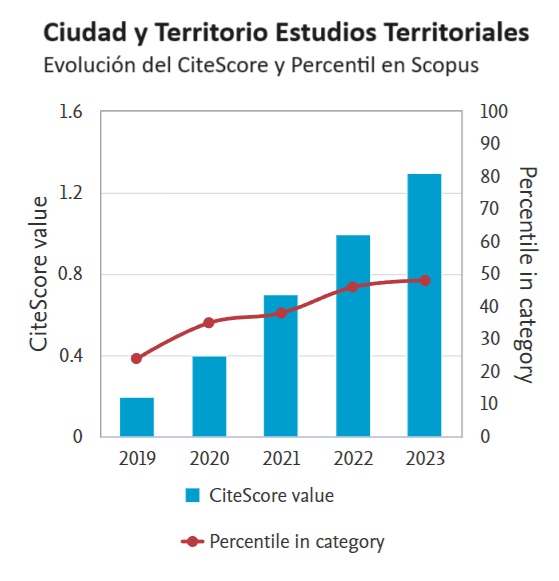La definición y delimitación del sistema metropolitano español: permanencias y cambios entre 2001 y 2011
Palabras clave:
Áreas metopolitanas, dinámicas urbanas, EspañaResumen
El presente artículo aborda el análisis del sistema metropolitano español en
el periodo 2001-2011 en lo que se refiere a su definición, delimitación y dinámicas básicas.
Para afrontar esa tarea, la investigación se centra en un ejercicio de delimitación de las
áreas metropolitanas españolas a partir de los datos censales de 2011 sobre movilidad
residencia-trabajo. El ejercicio de delimitación está basado en una metodología robusta,
plenamente contrastada en la experiencia comparada internacional, y que ya fue aplicada
a los datos del censo de 2001, lo que permite el análisis comparativo de los resultados
obtenidos entre ambas fechas de referencia. En este artículo, el análisis comparativo se
limita a evaluar los cambios habidos en la composición del sistema metropolitano español
como conjunto y en dos dimensiones básicas asociadas de sus componentes, una de
carácter territorial y otra demográfica. Los resultados muestran, en coherencia con su
carácter estructural, una notable estabilidad del sistema metropolitano español como
conjunto, acompañado a su vez por una fortísima dinámica demográfica. Si se desciende
a un nivel singularizado, el comportamiento no es compresible uniforme, siendo las diferencias
atribuibles más que a una lógica de jerarquía en el sistema a factores de naturaleza
territorial. En ese sentido, son las áreas metropolitanas del litoral mediterráneo e
insular las que presentan un mayor dinamismo y expansión territorial, respondiendo además
en muchos casos a unos procesos de urbanización masivos y de características singulares
que obligan a repensar la definición de lo metropolitano y sus variables para
delimitarlo.
Descargas
Descargas
Publicado
Cómo citar
Número
Sección
Licencia
Derechos de autor 2016 J. M. Feria Toribio, L. Martínez Bernabéu

Esta obra está bajo una licencia internacional Creative Commons Atribución-NoComercial-SinDerivadas 4.0.
Sin perjuicio de lo dispuesto en la legislación vigente sobre Propiedad Intelectual, y conforme a la misma, el/la los/las autor/a/es/as que publiquen en CyTET cede/n a título gratuito, de modo no exclusivo y sin límite temporal al Ministerio de Transportes, Movilidad y Agenda Urbana los derechos para difundir, reproducir, comunicar y distribuir en cualquier formato actual o futuro, en papel o electrónico, la versión original o derivada de su obra bajo licencia de Creative Commons Reconocimiento-NoComercial-SinObraDerivada 4.0 Internacional (CC BY-NC-ND 4.0), así como para incluir o ceder a terceros la inclusión de su contenido en índices, repositorios y bases de datos nacionales e internacionales, con referencia y reconocimiento en todo caso de la autoría del mismo.
Además, al realizar el envío, el/la los/las autor/a/es/as declara/n que se trata de un trabajo original en el que se reconocen las fuentes que han sido utilizadas en su estudio, comprometiéndose a respetar la evidencia científica y a no modificar los datos originales para verificar o refutar una hipótesis de partida; que el contenido esencial del mismo no ha sido publicado previamente ni se publicará en ninguna otra obra o revista mientras esté en proceso de evaluación en la revista CyTET; y que no se ha remitido simultáneamente a otra publicación.
Los autores deben firmar un Formulario de Cesión de Derechos, que les será enviado desde la Secretaría de CyTET una vez se acepte su artículo para ser publicado.
Con el objetivo de favorecer la difusión del conocimiento, CyTET se adhiere al movimiento de revistas de Open Access (OA) y entrega la totalidad de sus contenidos a diversos índices, repositorios y bases de datos nacionales e internacionales bajo este protocolo; por tanto, la remisión de un trabajo para ser publicado en la revista presupone la aceptación explícita por parte del autor/a de este método de distribución.
Se anima a las/os autoras/es a reproducir y alojar sus trabajos publicados en CyTET en repositorios institucionales, páginas web, etc. con la intención de contribuir a la mejora de la transferencia del conocimiento y de la citación de dichos trabajos.








 Enlace a CyTET en Linkedin
Enlace a CyTET en Linkedin